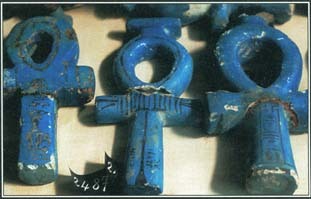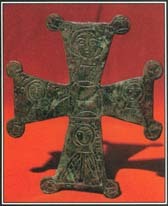Cross
One of the oldest and most widespread symbols in history, the cross is best known as a sign of the Christian faith. However, the cross has played a significant role in many other cultures as well. Peoples as different as the ancient Egyptians and modern peace marchers have adopted it to represent an idea they considered important.
Shapes and Uses of the Cross
Throughout the world and through the ages, people have used the shape of the cross to decorate religious articles, to protect against illness, to bring good luck, and for countless other purposes. Many different versions of the cross exist, including the Xshaped St. Andrews cross and the T-shaped tau cross (named after the Greek letter). In addition, a wide variety of items have been made in the shape of the cross, including small amulets and jewelry, church altars and gravestones, and decorations on flags and shields.
Among the ancient civilizations who used the cross as a religious symbol were the Egyptians. The ankh, or Egyptian cross, was a tau cross with a circle or oval on top. The T part of the cross represented life or wisdom, and the circle or oval stood for eternity. Under the pharaoh Akhenaten, the ankh became the symbol of the Egyptian sun god, and gods and pharaohs were often shown holding the cross. Early Egyptian Christians adopted it as a symbol of eternal life through Christ's sacrifice.
Other ancient peoples, such as the Phoenicians* of the eastern Mediterranean and the Aztecs of central Mexico, also used the ankh. For the Aztecs, it was a symbol of secret knowledge available to only a few.
A Fearsome Symbol
The swastika has come to be feared and despised because of its association with the Nazis in World War II. Yet historically, the swastika was widely used as a religious symbol. To some ancient peoples, it was a pictograph of the sun revolving in the universe. American Indians used it to symbolize the workings of the winds and the waters. To the Norse, the swastika represented Thor's hammer. Early Christians used it as a disguised cross on tombs during the time when it was dangerous to display a Christian cross. Hindus use the swastika, considered a symbol of good fortune, to decorate doorways and books.
amulet small object thought to have supernatural or magical powers
The Greek cross, with two equal bars that intersect in the middle, was adopted by many peoples. The ancient Assyrians, Babylonians, and Persians all used it to represent the basic elements—earth, water, wind, and fire—from which they believed all living things were created. They also marked religious articles with the sign of the cross. Ancient Buddhists and Hindus followed a similar practice. In addition, the Greek cross has been found on items used by the Druids of Celtic* Britain and by the Aztecs. But its meaning for these peoples has not been established.


In other cultures, the Greek cross represented the four principal directions (north, south, east, and west). The Plains Indians place the cross within a circle to signify the four main directions of the heavens. In the Bible, paradise is said to be divided by four rivers that form a cross. In parts of Africa, people believe that crossroads are places where the worlds of the living and the dead meet.
The Christian Cross
The cross is the most important symbol of Christianity. It stands for the cross on which Jesus was crucified and represents the greatness of God's sacrifice and the spiritual salvation that humans gained as a result.
A Changing Symbol. In the ancient Near East and Mediterranean world, crucifixion was used mainly as a method of execution for political and religious opponents, pirates, and slaves. The condemned were tied or nailed to a cross and died of exhaustion or heart failure.
Early Christians were hesitant to adopt the cross as their symbol. Many could not accept an instrument of death as the symbol of their devotion. Moreover, until the A . D . 300S, when Christianity became the official religion of the Roman empire and crucifixion was banned, open use of the cross could lead to persecution.
The earliest crosses were empty, emphasizing Christ's triumph over death and the eternal life available to humankind. By the 300s, the figure of a lamb was added over it, symbolizing Christ. Later the human figure of Christ was portrayed on the cross, emphasizing at first his divine nature but later his human suffering.
relics pieces of bone, possessions, or other items belonging to a saint or sacred person
The True Cross. According to legend, the cross on which Jesus had been crucified was found by St. Helena, the mother of the Roman emperor Constantine, during a pilgrimage to the Holy Land. The story relates that she found three crosses (Jesus had been crucified along with two thieves). To determine which of them belonged to Christ, Helena ordered that a corpse be brought and placed on each cross in turn. When the corpse was laid on one of the crosses, it came to life, thus showing that that was the cross of Christ. Fragments of the cross were later sold as relics and honored in churches throughout Europe.
* See Names and Places at the end of this volume for further information.
It was definitely a cross.
An